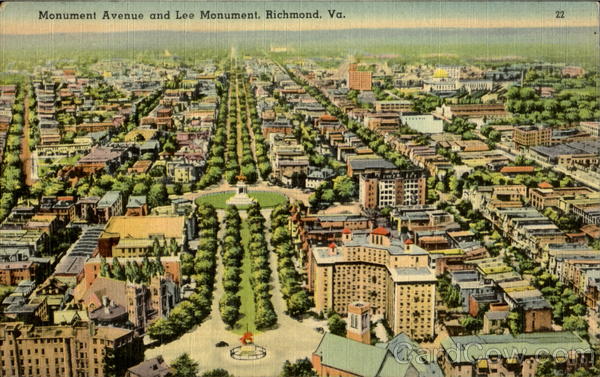
Monument Avenue And Lee Monument Richmond – Source CardCow.com
by Lil Tuttle
Four people – 3 current and 1 former Virginia Commonwealth University students – were arrested on September 16 during a protest against Richmond’s [VA] confederate monuments, which are part of the historical Monument Avenue Historical District national landmark designated by the U.S. National Park Service.
Three Virginia Commonwealth University students and one former student charged with covering their faces while protesting a pro-Confederate rally are facing a maximum of five years in prison under a 1952 law aimed at unmasking the Ku Klux Klan in Virginia.
Three of the four were arraigned Tuesday on one count each of wearing a mask in public to obscure their identity. The fourth is scheduled to be arraigned Wednesday.
It’s not as if the students weren’t warned in advance.
Police had said in advance of the event they would be strictly enforcing the state’s mask law that bars anyone over the age of 16 from wearing a “mask, hood or other device whereby a substantial portion of the face is hidden or covered” with the intent of concealing their identity.
The law was aimed squarely at deflating KKK membership when it was proposed by the governor after the Klan publicized plans to open a chapter in Richmond 65 years ago.
The Richmond Times-Dispatch reported in 1952 that the “measure is similar to legislation adopted by other Southern States in an effort to control Klan activities by requiring Klansmen to expose their faces to public view.”
Although the ACLU criticized officials for the arrest and arraignment of the masked marchers, it seems particularly fitting that marchers and protestors today are being held to the same accountability standards of full facial exposure as marchers and protestors in the past.
Equally fitting is the court date for the three current students. Judge Tracy Thorne-Begland set their trial for October 31 – Halloween.
Richmond’s Monument Avenue has existed for more than a century, with the first monument unveiled in 1890. The National Park Service describes the historical district this way:
A broad residential tree-lined street extending for some five miles from inner city Richmond westward into Henrico County, the avenue takes its name from the series of monumental statues that mark its major intersections, generally in the center of traffic circles. For many years, the street was Richmond’s ceremonial parade route. Included among those who have journeyed to the Governor’s Mansion along “The Avenue” are Marshall Foch, Commander Richard Evelyn Byrd, Winston Churchill, General Eisenhower, and Queen Elizabeth.
Its value today is mostly as a tribute to art and architecture.
Over a period of some 30 years, Monument Avenue became the site of a splendid series of architecturally dignified town houses and apartment buildings. These reflect the achievements of many prominent architects, such as John Russell Pope, William Lawrence Bottomley, Duncan Lee, D. Wiley Anderson, and Richmond’s Marion J. Dimmock and Baskervill & Lambert.
Monument Avenue’s final monument, erected in 1996, was designed to honor native son, Arthur Ashe.
The sixth and last statue, the Arthur Ashe Statue, stands at the intersection of Monument Avenue and Roseneath Road on the last block of the historic district. The dedication in 1996 of this monument to Richmond’s native humanitarian, scholar, and athlete on Ashe’s birthday, July 10, drew thousands of spectators.
